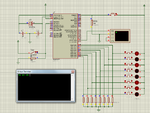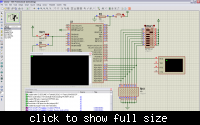zia.newversion
Member level 5
Hi there.
So...
I am back again with another problem. Here is the code (asm).
The purpose of the program to transmit the data on a parallel port to USART TX line (using built in module - NOT manual implementation of USART).
There will be a DIP switch on PORTD in my conceived hardware model, with LED on switch to indicate if it is on or off. There will be MAX232 or relevant on USART outputs (but Proteus does not require it AFAIK).
In addition to that, there will be a selection switch on RA1, which will be used by controller to decide whether to use automatic or manual transmission modes.
In automatic mode, the controller automatically transmits whatever is on PORTD when a TMR0 interrupt occurs (which it does very frequently). This mode is useful when taking sampled data from an external ADC, for example. In manual mode, the controller will require a hardware INT or RB0/INT to be provided for it to start tranmission.
And that's that. The code:
I have revised the code many times so as not to mickey myself out because of some silly mistake. It seems (to me) there is no silly mistake. However, there is no guarantee.
In any case, the ISIS simulation files and MPLAB project files are attached. If anyone could look into what is causing the problem, I shall be duly grateful.
P.S. I know the algorithm has some design flaws. I did not have time to re-evaluate my approach. So I am posting it as is. I shall be making changes to the algorithm (_sthint and _sttint are placed at awkward positions, I was thinking more like enabling both INT and TMR0 interrupts, and then polling them in ISR). But apart from that, if I could make this one work, I shall be able to optimize and remove the design or approach flaws later.
So...
I am back again with another problem. Here is the code (asm).
The purpose of the program to transmit the data on a parallel port to USART TX line (using built in module - NOT manual implementation of USART).
There will be a DIP switch on PORTD in my conceived hardware model, with LED on switch to indicate if it is on or off. There will be MAX232 or relevant on USART outputs (but Proteus does not require it AFAIK).
In addition to that, there will be a selection switch on RA1, which will be used by controller to decide whether to use automatic or manual transmission modes.
In automatic mode, the controller automatically transmits whatever is on PORTD when a TMR0 interrupt occurs (which it does very frequently). This mode is useful when taking sampled data from an external ADC, for example. In manual mode, the controller will require a hardware INT or RB0/INT to be provided for it to start tranmission.
And that's that. The code:
Code ASM - [expand]
I have revised the code many times so as not to mickey myself out because of some silly mistake. It seems (to me) there is no silly mistake. However, there is no guarantee.
In any case, the ISIS simulation files and MPLAB project files are attached. If anyone could look into what is causing the problem, I shall be duly grateful.
P.S. I know the algorithm has some design flaws. I did not have time to re-evaluate my approach. So I am posting it as is. I shall be making changes to the algorithm (_sthint and _sttint are placed at awkward positions, I was thinking more like enabling both INT and TMR0 interrupts, and then polling them in ISR). But apart from that, if I could make this one work, I shall be able to optimize and remove the design or approach flaws later.

